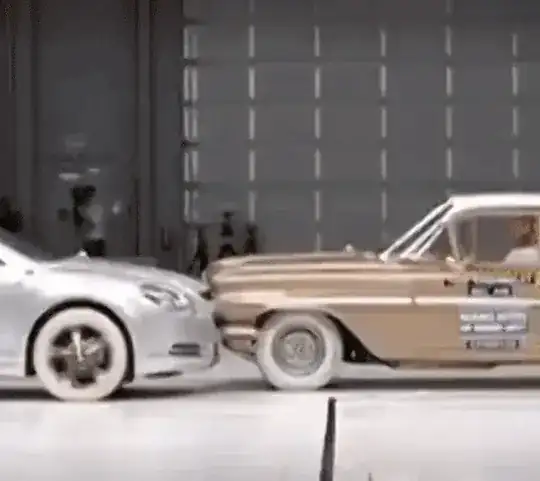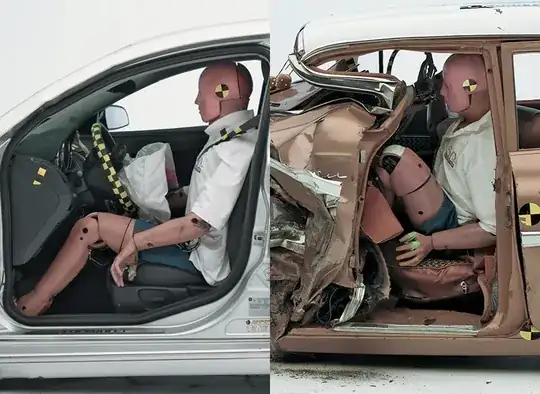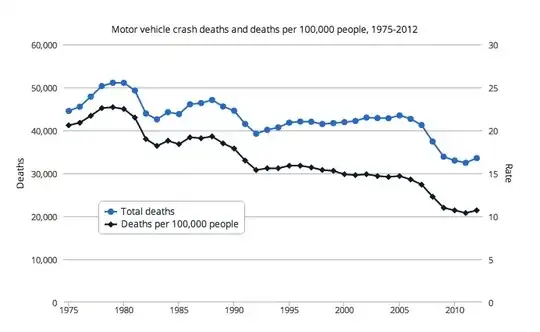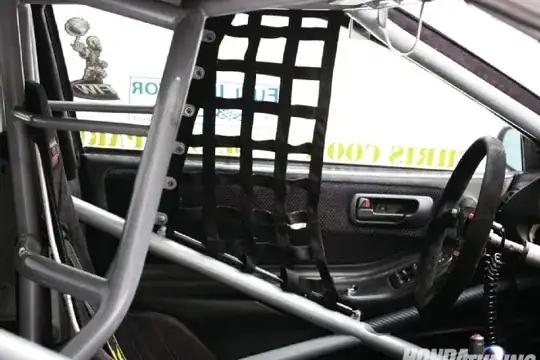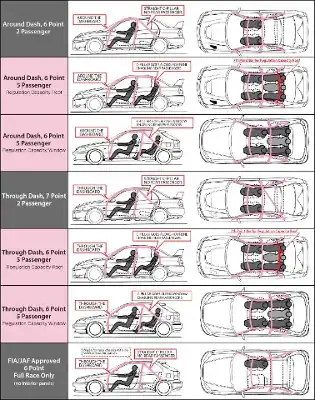Modern cars are safer, but not as much as the the auto industry would have you believe, nor as much as an average person who sees crash tests on TV that look good believes. The average person doesn't analyze the crash test dummy data nor considers how much real world conditions vary from a laboratory crash test.
Much of the safety increase comes from increased side impact crash protection, and the better small overlap or angled front end / side impact crash protection offered by a unibody. Front end or head on crash protection leaves much to be desired.
Much of the data available concerning vehicle safety statistics is created for the insurance industry and government use for an entire population, and therefore can be highly misleading to an individual who wants buy a safe vehicle and operate it in a safe manner. A great example of this is bundling vehicle fatality statistics of belted occupants with unrestrained occupants. A safety concerned individual is going to use a seat belt and doesn't need to see statistics and injury reduction advice that is targeted at unrestrained occupants.
The chart that shows vehicle fatalities going from around 5 deaths per 100,000,000 miles traveled in the 1970s to 1.11 today is misleading. Most of that reduction is due to increased seat belt use and the creation of the interstate highway system. Much of the remaining decrease in fatalities that is due to increased vehicle safety has been offset by the higher average speeds that people drive at today on highways. So a belted person driving on a 2 lane highway today isn't really much safer than it was in the 1970s.
The list of fatalities per vehicle make and model is also made for insurance companies and useless for someone choosing a safe vehicle. Fuel efficient cars are rated as more dangerous partially because they are driven more, but the statistic doesn't take this in to account. Also, a Corvette is not 10 times as dangerous as the average car. This is driver behavior. The 4 wheel drive version of the F-150 is not twice as dangerous as the 2 wheel drive version. The 4 wheel drive version attracts a certain demographic.
Vehicle safety priority goes something like this, from most important to least important:
- Whether or not 3 point seat belts are worn. Half of vehicle fatalities in the US are caused by the 10% of occupants who are unbelted [1].
- The driver or driving habits, especially speeding or driving too fast for conditions.
- The types of roads where the vehicle is driven, such as city, rural highway, or physically divided highways.
- Finally, the size and safety rating of the vehicle.
4rd place can be put in 3nd place or even 2nd place for importance depending on how the vehicle is used. For instance, if the vehicle is used primarily in city traffic where accidents are often moderate or mild but can be impossible to to avoid, then this would belong as #3 or even #2. For primarily highway use, where a fatality is often unavoidable no matter if it is a classic car or a modern car, then this belongs in 4th place.
Here are some reasons why modern cars are not as safe as it would appear:
- Many vehicles (except Volvos) are still designed to look good on crash tests and allow people to walk away from mild accidents, and not to do well in more severe real world crashes which have a lot more variables. Optimizing for crash tests can have a detrimental effect on other types of crashes.
- The NHTSA is still doing the full overlap 35 MPH crash tests that they did in the 70s. This was good at the time for testing seat belt effectiveness and for small injuries, but it is worthless for testing survive-ability in real world fatal crashes in belted occupants.
- The IIHS has been doing the 40 MPH 40% overlap crash in to a deformable barrier tests for over 2 decades now. This has really helped address the short coming of the 35MPH NHTSA crash test, where vehicle makers could make a vehicle with a soft front end to help reduce injuries and gain 5 NHTSA stars. But the IIHS has put a lot of emphasis on preventing small injuries or non life threatening injuries, and not on survive-ability in more severe crashes. Also they only test one occupant and no rear seat occupants. Designing for the 40 MPH IIHS test can have a detrimental effect on other types of crashes. The IIHS also uses a deformable barrier that acts as a crumple zone that doesn't exist in a real world crash. This makes an equivalent crash in to a solid barrier to be a bit less than 40 MPH. The lighter the vehicle, the more effect the deformable barrier has.
- The IIHS crash tests are done without the engine running, so testing if the vehicle will catch on fire after the crash is not done.
- Crash tests are generally not done above 40 MPH. Volvo is an exception to this. Simply making the car pass the 40 MPH crash test and not considering steering wheel movement or the effect of seat belt load limiters at higher speed crashes seems to have occurred. Crashing a vehicle that has a Good rating on the 40 MPH 40% overlap crash test at 50 or 55MPH can easily change the crash from a walk away one to a fatal one.
- Crash tests often don't put dummies in the passenger seats of cars. If they did, it would likely show that in driver side overlap crash tests that the passengers are better protected in older cars than newer ones. This would become a bigger issue if higher speed tests were done, as newer stronger cars may expose everyone to a fatal crash pulse, but an older car would let the driver die but allow everyone else survive. This is the situation, where lives of all the passengers are taken in to account instead of just the driver, is where older cars, especially good 90s unibody cars, are safer than modern cars.
- To reduce injuries in the more rigid front end structures that modern cars have, seat belt load limiters have been added. These let the seat belt out to reduce the force applied to a person in a crash by the seat belt. The problem is that this has been optimized for the 40 MPH crash test and what happens at higher speeds isn't made public. Secondly, there is only one setting available per vehicle. A young tall healthy man needs a much higher seat belt load limit than a small frail elderly person. If you fit the 1st category, this device could very well cost you your life in a more severe head on crash.
- The airbags in modern cars tend to be softer and smaller than the old 1st generation ones from the 90s. Although you can be killed by a more powerful older airbag if it deploys in a fender bender if your body is right next to it when it shouldn't be, if you are in a more severe head on crash you'll wish you had it.
- The increase in safety of modern cars with more rigid front end structures that are in high speed head on crashes at over 40 MPH is partially do to the anticipation that the modern vehicle will be in a head on crash with an older vehicle with a softer front crash structure that serves as the crumple zone, at the expense of killing the person in the other car. If two modern cars with rigid front ends hit each other at 50MPH it could easily be a fatality for both.
- The old versus new crash tests that demonstrate how much better the safety in a modern car is are usually dishonest. They often use an older car that is several hundred pounds lighter than the modern car being tested in their head on crash. This is a very unfair comparison. They don't even test head on crashes between modern vehicles of the same safety generation with that much weight difference, probably due to how bad it would look for the lighter vehicle. I believe the disadvantage from G force exposure alone of being in a lighter vehicle in a head on crash with a heavier vehicle is the square of the mass of the heavier vehicle divided by the lighter vehicle. The difference can be huge. Please correct me if I am wrong.
- The popularity of taller SUV type vehicles has caused a huge increase in the number of pedestrian fatalities, due to getting hit up higher where the injuries become life threatening. It's also worse for a traditional lower vehicle that gets broad sided or read ended by a taller SUV.
- Vehicles are not tested for rear end crash safety. Some seats do not remain upright in a severe rear end crash and the occupant's head is allowed to make contact with the rear end intruding structure. Hatch backs are extremely dangerous for rear seated passengers. A 30 MPH rear ending by a truck or SUV is likely fatal for the rear passengers. The smaller rear ends resulting from the trend to have more compact cars has reduced rear end crash safety compared to traditional large American cars. The idea that it is safer to sit in the back likely doesn't take in to account compact hatch back vehicles.
- The presence of front wheel ABS (without ESC) has made it so that locking up the brakes can no longer be used as a method of forcing a vehicle to go straight and regaining control. Although this reduces the likelihood of hitting another vehicle by being able to swerve out of the way, in trucks and SUVs this can increase the likelihood of a dangerous roll over accident.
- There is a fundamental limit on survive-ability in front end crashes that is caused by the distance between the front bumper and the front seats. The increase in popularity in compact cars has had a detrimental effect on safety. Not only are the cars harder to work on, but there is little room up front to smash in and reduce the crash pulse. Look at how the Kia Rio that weighs around 2600 pounds and has a short hood has about double the fatality rate per mile compared to the average 3200 pound car. They crashed a Kia Rio in an old versus new test and the seat belt load limiters extended the seat belt much farther than I am comfortable with. In a higher speed crash things would get bad for the Kia really soon. It's not hard to find images on the Internet showing fatal crashes where there is minimal intrusion in to the passenger compartment.
An example these things caused the faulty rear seat belts that shear off in high speed crashes in certain Honda CRVs to go out undetected until some fatal crashes happened.
In an unrelated issue that happens to also be a Honda CR-V, and likely reflects the rest of the auto industry as well, here is an example of a CR-V that has a Good rating at 40 MPH in a 40% overlap crash test, but at 50 MPH it turns in a crash with serious or fatal injuries. It looks like the seat belt load limiter allowed the test dummy to move forward in to the intruding structure and steering wheel where its neck and head made hard contact with the bottom of the upward and rearward moving steering wheel. Take a look at the 1996 Toyota Camry crash test with its huge airbag and then look at the small airbag in the 2010 CR-V and how the dummy's neck goes right through the edge in to the steering wheel. See the 40 MPH and the 50 / 55 MPH fatal Honda CR-V crash tests here: https://www.youtube.com/watch?v=RWwGFDynOHo
The TV show 5th Gear did a 60 MPH moderate overlap crash test between an old real wheel drive Volvo and another heavier real wheel drive car. They said that there would be no survivors, which is absolutely true for the drivers. But that is only part of the story. The rest of the people in the cars would have a greater chance of survival than they would in a modern stronger car due to the softer structure. Watch it here: https://www.youtube.com/watch?v=R-_oOYzNcAw
Only 10 MPH can make a big difference. In the 1970s a 30 MPH crash in a car with seat belts would be survivable, but 40 MPH could be fatal. Today 40 MPH is survivable with minor injuries thanks to the IIHS, but 50 MPH is likely fatal. During this time the average speed driven on two lane highways has gone up by about 10 MPH too. So we're back where we started.
If you drive a 90s car that has an acceptable rating on the IIHS 40% overlap test, and you have your seat adjusted all the way back away from the steering wheel, and it has an airbag, and if it has one, a seat belt load limiter that isn't too weak for you (most 90s cars don't have load limiters anyway), you may not be that much worse off in a head on crash than someone who is driving a late model car, as long as they are the same weight. If you had a newer car to match theirs, it just means that you would both die. If you're considering replacing your mid sized 90s car with a modern compact car, you could be less safe in the modern compact car. This is especially true if you have passengers in your car. In an overlap head on crash that is worse for the front seat occupant on the side that gets hit, the rest of your passengers will have a greater chance of survival due to the softer structure and likely larger distance between the front seats and bumper. No car has airbags in the rear sets, and the only way to make those passengers safer (aside from rear facing seats or 5 point seat belts) is with a longer and softer area in front.
Putting a rear facing child seat in the front in a vehicle without a passenger airbag might actually be safer if the vehicle is a hatch back. Rear passengers die so easily in those types of vehicles. The government may say to put children in the back, but if they care so much about our safety, then why are they still doing 35 MPH crash tests? Disable the airbag and sit up front! Don't ride in the back of a hatchback! Even in a regular car if that Jeep that is behind you rear ends you at full speed I hope nobody is sitting in the back.
On a two lane highway sometimes bigger is the only thing you can do. You might drive 55 MPH, but the vehicle in the other lane won't, and you're not going to drive 40 MPH to balance the situation. Take a look at this horror crash where being bigger at almost 6000 pounds is what saved the not at fault passenger: http://metroforensics.blogspot.com/2017/06/15-year-old-eric-neibaur-and-his-sister.html
So for a 1960s classic with all that being said, if the classic does not have seat belts, you should not drive it on a regular basis, and it should absolutely not be used as a daily driver in the city. Someone pulling out in front of you can be a fatal crash for you.
If it does have 3 point seat belts, then it can be used as a daily driver, but I don't recommend driving it in the city, as it will be significantly more dangerous in mild and moderate accidents which are often not your fault and unavoidable. This is mostly due to very weak side impact protection and very poor small overlap crash protection found on most old body and frame vehicles (well below what the IIHS calls poor for small overlap).
For others, if the classic is an 80s unibody or something like a Crown Victoria with a full perimeter frame then you'll be a lot better off than a 60s classic. You'll have at least some federally mandated reinforcement in the door for side impact protection.
Footnote:
1: This 10% of unrestrained occupants accounting for 50% of accidents fatalities statistic would mean that an unrestrained occupant is 5 times more likely to die per mile traveled. However, this does not take in to account that unrestrained drivers may also be more likely to engage in more risky driving behaviors, or could have different driving habits. So the actual figure could be less than 5.
